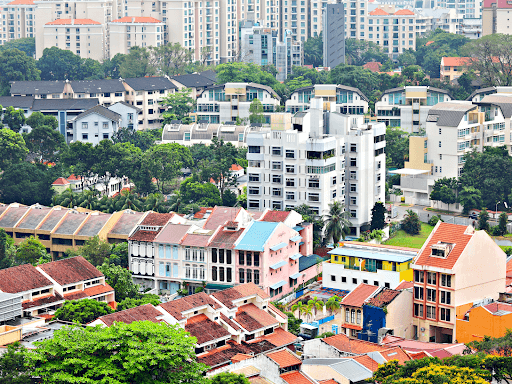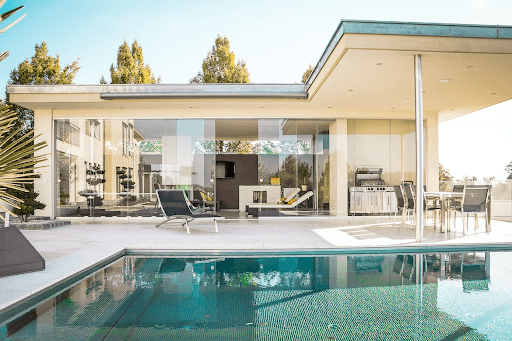With the increasing population in Singapore, many are choosing private properties over HDBs – specifically landed properties. Who can blame them with the exclusivity and freedom that these plots of land offer? From architectural design to interior design, landed properties give owners the ability to create one of a kind masterpieces that other property owners can only dream about! So today we’re taking you on a crash course through 4 things you need to know about buying a landed property in Singapore.
Types of Landed Properties
Landed properties come in all forms of shapes, sizes, colors, heights, and more. However, they can be classified into 3 categories – Detached house, Semi-Detached house, and Terrace houses.
Landed Properties: Detached Houses
Detached houses, commonly known as Bungalows, are defined by the Urban Redevelopment Agency (URA) as a free-standing dwelling unit within a plot of land. One that is located within a Good Class Bungalow (GCB) area like Sixth Avenue, Queen Astrid Park, and Dalvey Estate would have a size of at least 1400sqm or 15070 sqft. To put it simply, these houses are at least about fifteen 4-room flats combined or 5 tennis courts combined. Outside the GCB area, the detached house can sit on a plot of land that is minimally 400 sqm or 4306 sqft. That corresponds to about four 4-room flats combined or 1.5 tennis courts combined.
Landed Properties: Semi-Detached Houses
The second type of landed houses is the Semi-Detached houses, or Semi-D for short. These are properties that are attached to another landed property. Typically, they are attached by the sides but they can also be attached back to back. Semi-detached houses and corner terraces are at least 200 sqm or 2153 sqft, about half the minimum size of a bungalow.
Landed Properties: Terrace Houses
Lastly, there are terrace houses. A terrace house forms part of a row of at least 3 houses sharing a common boundary with common walls in between them. The land size of a terrace house is approximately 150 sqm which translates to 1615 sqft. These numbers represent the smallest terrace house so of course, these numbers can only grow.
Reserved for Singaporeans
Even though it is private property, the government still has a say on who can own it. Non-Singaporeans are not allowed to purchase landed properties. Only Singaporeans are able to own landed properties with no questions asked. That said, Permanent Residents (PRs) for at least 5 years can apply to be owners of landed properties. However, this is not a straightforward process. Applications are assessed on a case-by-case basis, based on factors such as whether you have made economic contributions to Singapore
The Sky is NOT the Limit
Tearing the property down and rebuilding it, or even adding another floor, is not as simple as stacking Lego blocks. You will have to check out what the maximum number of floors allowed by URA is for your plot under the Landed Area Housings Plan. Land zoned for 3 floors permits you to have 3 floors plus an attic, which usually translates to a higher land price. On the other hand, land zoned for 2 floors allows you to build 2 floors plus an attic, lowering the price of the land.
Professional inspectors needed
With huge power comes huge responsibilities. In this case, with huge land space, comes huge problems! A landed property’s assessment may be more tedious as compared to that of an apartment. Engaging a professional would be encouraged to ensure that nothing goes wrong in the process without any headaches! Here are some areas that could be a cause for concern when you purchase your property.
Foundation
When you hear the words “foundation” and “issues”, it’s time to reconsider your purchase! It is an issue whose resolution could cost you badly – both money and time. It is essential to look for homes with compromised foundations. This can highlight misaligned walls, window frames, and doors, as well as cracks in the house.
Moisture
Issues related to moisture can also be a wet blanket to your plans for a dream home. It is commonly found in landed properties with a basement. Some of the obvious signs include leaks or mold growing in the house, and should be avoided at all costs.
Soil
It would be ideal for your home to sit in an area containing compact soil in contrast with loose and overly soft soil. Loose soil may require the installation of sheet piling so as to provide earth retention and excavation support. The total cost may differ for each case but either way, it would cost a pretty hefty sum.
Roofing
When finding the ideal roof over your head, it is essential that the roof actually works. A leaky roof should be avoided at all costs! They require a large amount of money to fix, so you should either have the previous owners fix it, or find another home. However, if the roof is slightly discolored, you can throw a coat of paint or clean it with bleach.
Looking for your dream home? Check out Sevens Group listings and contact our Developer Sales Team today! Your perfect home is just a click away.



